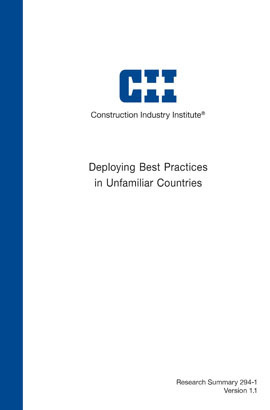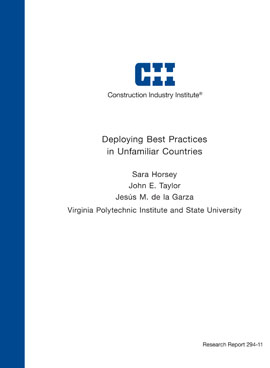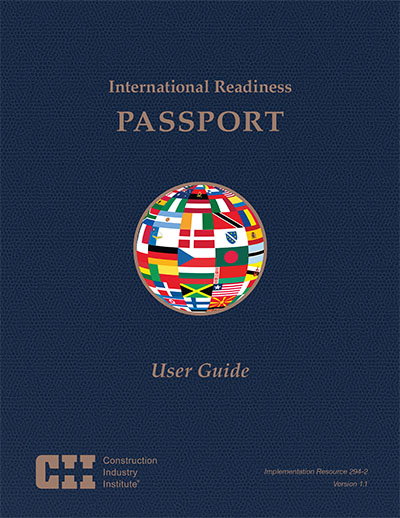
Deploying Best Practices in Unfamiliar Countries, Version 1.1
Rapid market globalization has created new opportunities and new challenges in virtually every industry in recent decades, and the global expansion of the construction market has been particularly pronounced. To meet the demands of this continuing market growth and to ensure project success, the engineering and construction industry needs processes, metrics, and tools to improve the deployment of best practices in unfamiliar countries. In response to this need, the Construction Industry Institute (CII) formed Research Team (RT) 294 to develop a process to improve the systematic deployment of best practices in unfamiliar locations. Specifically, the CII Research Committee charged RT 294 with the task of developing a process that could be applied to any best practice in any country, as opposed to focusing on a specific best practice or on deploying best practices in any specific countries.
To develop this process, RT 294 identified a series of issues that organizations commonly encounter when deploying best practices in unfamiliar countries. The team identified these issues through a combination of content analysis, expert interviews, and focus groups. It then used the Delphi method to verify the relevance of these issues through expert opinion. Issues were grouped into the following nine best practices categories: 1) Business Customs, 2) Communications; 3) Cultural and Social; 4) Geography and Logistics; 5) Human Resources and Workforce; 6) Legal and Contracts; 7) Market and Political Conditions; 8) Regulations; and 9) Safety and Security. The Analytic Hierarchy Process (AHP) was then used to establish weightings for each of the issues within the nine categories, and to determine the relative importance of each category to overall deployment readiness. The team then used the weightings, issues, and best practices categories to create a systematic scoring metric for companies to determine their readiness to deploy best practices in unfamiliar countries.
To help companies overcome any gaps in readiness indicated by this metric, the team then developed a series of mitigation strategies for creating action plans to address readiness gaps. This process involved conducting an extended series of interviews and focus groups, and generated a series of mitigation strategies for each of the issues identified in the Delphi study portion of the research. Team members then rigorously reviewed and edited the resulting strategies and asked subject matter experts in their respective companies to review them to ensure that they were both thorough and relevant.
Following this development of the assessment metric and recommendations for mitigation, the team developed the International Readiness Passport (IRP). This Excel-based tool automatically determines the gaps in readiness, calculates a readiness score, and provides the appropriate recommendations for improving best practice deployment. First, it presents a readiness self-scoring process on each of the issues in all nine categories, and then multiplies the inputs by the issue weightings. Once completed, the IRP tool generates a report that isolates the relevant items of concern and presents the corresponding mitigation strategies to address gaps in readiness.
To ensure that the IRP tool is capable of facilitating the systematic deployment of best practices in unfamiliar countries, the team performed a series of retrospective internal and external validity tests. These validation trials confirmed the accuracy and relevance of the tool&##8217;s outputs, as well as its functionality.
(RS294-1, p. 15, Table 3)



